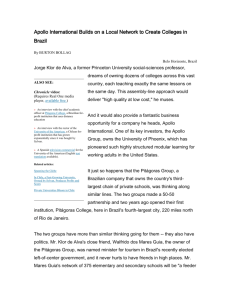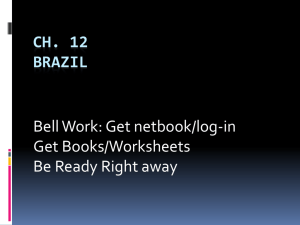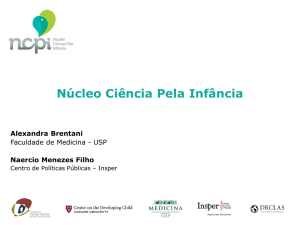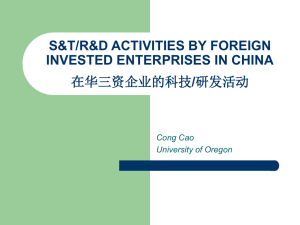BRAZIL Danilo de Melo Costa
advertisement
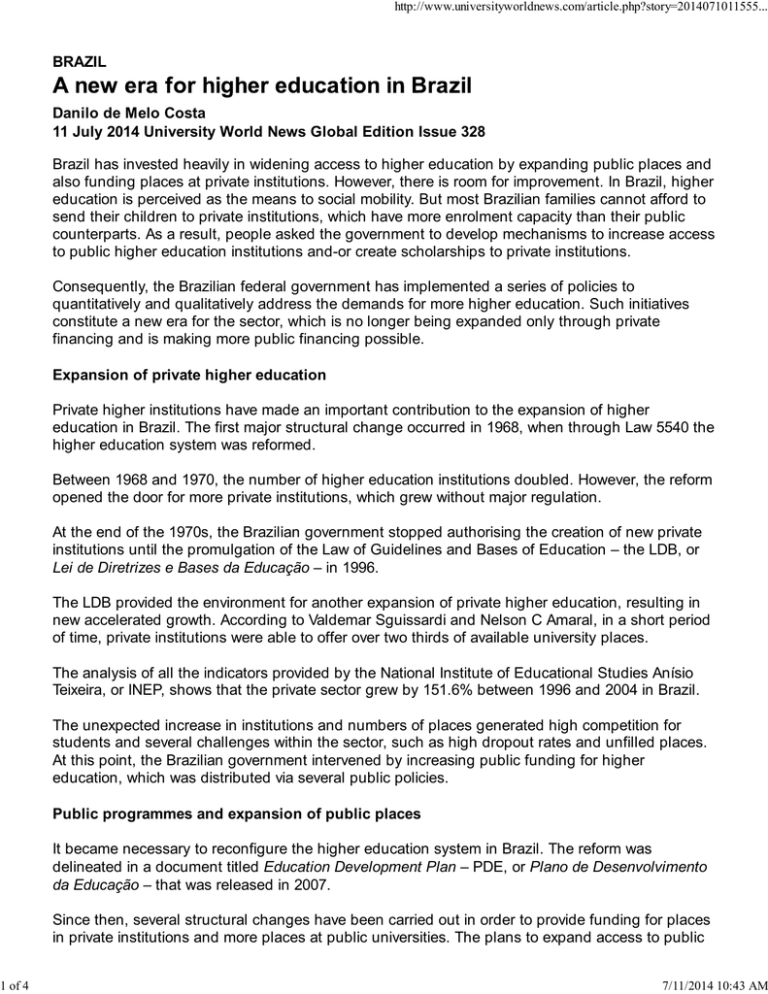
http://www.universityworldnews.com/article.php?story=2014071011555... BRAZIL Danilo de Melo Costa 11 July 2014 University World News Global Edition Issue 328 Brazil has invested heavily in widening access to higher education by expanding public places and also funding places at private institutions. However, there is room for improvement. In Brazil, higher education is perceived as the means to social mobility. But most Brazilian families cannot afford to send their children to private institutions, which have more enrolment capacity than their public counterparts. As a result, people asked the government to develop mechanisms to increase access to public higher education institutions and-or create scholarships to private institutions. Consequently, the Brazilian federal government has implemented a series of policies to quantitatively and qualitatively address the demands for more higher education. Such initiatives constitute a new era for the sector, which is no longer being expanded only through private financing and is making more public financing possible. Expansion of private higher education Private higher institutions have made an important contribution to the expansion of higher education in Brazil. The first major structural change occurred in 1968, when through Law 5540 the higher education system was reformed. Between 1968 and 1970, the number of higher education institutions doubled. However, the reform opened the door for more private institutions, which grew without major regulation. At the end of the 1970s, the Brazilian government stopped authorising the creation of new private institutions until the promulgation of the Law of Guidelines and Bases of Education – the LDB, or Lei de Diretrizes e Bases da Educação – in 1996. The LDB provided the environment for another expansion of private higher education, resulting in new accelerated growth. According to Valdemar Sguissardi and Nelson C Amaral, in a short period of time, private institutions were able to offer over two thirds of available university places. The analysis of all the indicators provided by the National Institute of Educational Studies Anísio Teixeira, or INEP, shows that the private sector grew by 151.6% between 1996 and 2004 in Brazil. The unexpected increase in institutions and numbers of places generated high competition for students and several challenges within the sector, such as high dropout rates and unfilled places. At this point, the Brazilian government intervened by increasing public funding for higher education, which was distributed via several public policies. Public programmes and expansion of public places It became necessary to reconfigure the higher education system in Brazil. The reform was delineated in a document titled Education Development Plan – PDE, or Plano de Desenvolvimento da Educação – that was released in 2007. Since then, several structural changes have been carried out in order to provide funding for places in private institutions and more places at public universities. The plans to expand access to public 1 of 4 7/11/2014 10:43 AM http://www.universityworldnews.com/article.php?story=2014071011555... places were performed under three fundamental modalities: Federal higher education Distance higher education Vocational higher education The federal higher education initiatives were described in the Plan of Reorganisation and Expansion of Federal Universities – REUNI, or Programa de Apoio a Planos de Reestruturação e Expansão das Universidades Federais. With this programme, in return for the large investment – about US$900 million – the federal government aimed to increase the number of undergraduate courses in public universities to 3,601 and the number of places to 227,260 in 2012. The programme also intended to increase the number of evening courses to 1,299 and the number of places on them to 79,215. In addition, there was great concern regarding the training of teachers in basic education; therefore, the government increased the number of teaching certification courses – those that prepare teachers for basic education – to 1,198 and the number of places to 79,191. The initiatives aimed at expanding distance higher education were executed through the Open University of Brazil – UAB, or Universidade Aberta do Brasil. The latest data released by the Coordination for the Improvement of Higher Education Personnel, or CAPES, shows that between 2007 and July 2009, 557 face-to-face support centres were approved and implemented, resulting in the creation of 187,154 places. In August 2009, over 163 new centres were selected to address the needs of the population, increasing to 720 centres. By the end of 2013, the system had expanded its cooperation network to reach all public higher education institutions in Brazil and accept 800,000 students a year. Since it was established, the Open University of Brazil has received public funding of over US$300 million. With regard to vocational higher education, federal technical schools were upgraded to federal institutes of education, science and technology – IFETs, or Institutos Federais de Educação, Ciência e Tecnologia. This reorganisation led to the greatest expansion in the history of Brazilian vocational higher education. From the emergence of the first schools in 1909, to 2002, 140 vocational schools were created. In accordance with the goal of expanding vocational higher education, the government expected to create 214 more schools, reaching a total of 354 schools by the end of 2010. However, with public funding of over US$500 million for the expansion of vocational education and the goal of creating 500,000 places countrywide, the Ministry of Education intends to exceed this goal. All these initiatives have contributed greatly to the growth of public higher education. However, as 2 of 4 7/11/2014 10:43 AM http://www.universityworldnews.com/article.php?story=2014071011555... previously stated, the largest number of places is still concentrated in the private sector. For this reason, there has been a great effort to develop public policies to increase the number of private places. Public financing for private places To support the expansion and democratisation of higher education, the federal government has invested public funds in two programmes to increase public and private seats: Financing of Higher Education Students – FIES, or Fundo de Financiamento ao Estudante do Ensino Superior. Students study with funding from the government until completion and have a grace period for repayment of the amount borrowed of 18 months at a rate of 3.4% per year after graduation. University for All Programmes – PROUNI, or Programa Universidade para Todos. Economically disadvantaged students receive scholarships of 25%, 50% and 100% in private higher institutions, and there is no need to pay the government after completion. With respect to the FIES, data from the latest report released by the Brazilian Court of Auditors show that 1,459 institutions were part of the programme in 2007. At the end of that year, FIES had 467,600 active financing contracts and aimed to issue about 700,000 contracts by the end of 2011. Between its creation and 2012, PROUNI offered more than 1.7 million scholarships. With the creation of the Education Development Plan in 2007, FIES started to work together with PROUNI. Students who have a PROUNI partial scholarship (50% or 25%) may request FIES to finance the rest of their monthly fees, ensuring their permanence in private higher education institutions. All these public investments and programmes represent a new moment in Brazilian higher education, which is shown in the Census of Higher Education. Census of higher education and the new era Data from the last Census of Brazilian Higher Education (2011) show changes in enrolment, divided into two administrative categories – public and private – and in the following forms: face-to-face and distance education. There has been an increase in the number of places in public and private education, including both face-to-face and distance education. These data indicate that public funding and policies regulated by the government have contributed significantly to the expansion of higher education in Brazil. This expansion can be seen in the following categories: Face-to-face public education, REUNI and IFETs: 33% growth between 2007, when the programmes were created, and 2011. Distance public education, UAB: 77% growth between 2006, when the programme was created, and 2011. Face-to-face private education, FIES and PROUNI: 41% growth between 2002 and 2011. Indicators show that public funding, along with several public policies, has increased the number 3 of 4 7/11/2014 10:43 AM http://www.universityworldnews.com/article.php?story=2014071011555... of places (and therefore enrolment) in public and private institutions in a unique manner and constitute a new era of higher education in Brazil. Final thoughts As society began to perceive higher education as the primary way to improve social status, access to higher education has been discussed at several levels and in several social spheres. Since then a number of initiatives, especially the PDE, have been created and programmes like REUNI and PROUNI, articulated together with the FIES, UAB and IFETs, have been the main pillars for the reformulation of Brazilian higher education. Through these programmes, public funding has been allocated for higher education. Brazil seeks to become the fifth world power over the present decade by increasing its gross domestic product and human development index, while decreasing unemployment rates. To achieve these goals, the country must democratise access to higher education because education is considered the driving force for development. This article shows the evolution of a new era in Brazilian higher education. However, there is still some room for improvement: REUNI, which was scheduled to end at the end of 2012, should continue. Some researchers suggest the creation of REUNI 2 because there is room for progress in federal higher education. IFETS and UAB should not promote only quantitative expansion. It is necessary to allocate public funding to increase the quality of education through these programmes. FIES and PROUNI should be united in a single process. A student who is eligible to receive the PROUNI should be automatically eligible to get the FIES. This would facilitate the financing of remaining monthly fees to students who receive partial PROUNI scholarships. Programmes that have similar objectives should be managed by the same board, something that does not happen currently. Finally, the federal government should proceed with the creation and advancement of effective public programmes. It is necessary to raise the profile of Brazilian higher education. We should consider it an important pillar of our development and a vital means to transform the country. * Danilo de Melo Costa is based at the Universidade Federal de Minas Gerais, or UFMG, in Brazil but is currently working with Associate Professor Qiang Zha at York University’s faculty of education in Toronto, Canada. This article was first published in the newsletter of the Higher Education SIG, Comparative and International Education Society, CIES. University World News http://www.universityworldnews.com/article.php?story=20140710115554910 4 of 4 7/11/2014 10:43 AM




